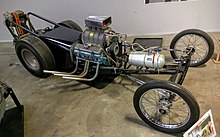Front engine dragster
With the transition from stripped-down production frames to purpose-built ones, the engine was moved rearward so more of its weight would be on the rear (driving) wheels for increased traction.
This procedure was necessary until 1976, when the National Hot Rod Association (NHRA) mandated that all cars be capable of being started without pushing.
[5] The slingshot dragster's tail-heavy design, coupled with no rear suspension and steadily-increasing engine power, often resulted in high-speed control problems that led to crashes.
By the late 1950s, dragster power had increased to where tire-smoking wheelspin would occur over a considerable distance, resulting in a tendency for the car to suddenly drift out of control—the tail-heavy design of the slingshot made recovery difficult.
As tire technology improved, wheelstands became a problem and often had to be counteracted by attaching ballast to the front axle, sometimes hundreds of pounds' worth.
Driveline components, especially the clutch and flywheel assembly, could burst at high engine rpm, resulting in serious or fatal injuries from the violent expulsion of metal fragments.

